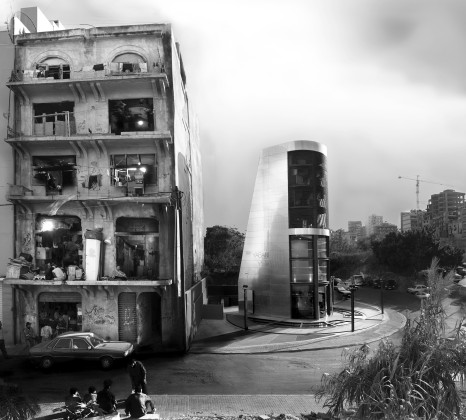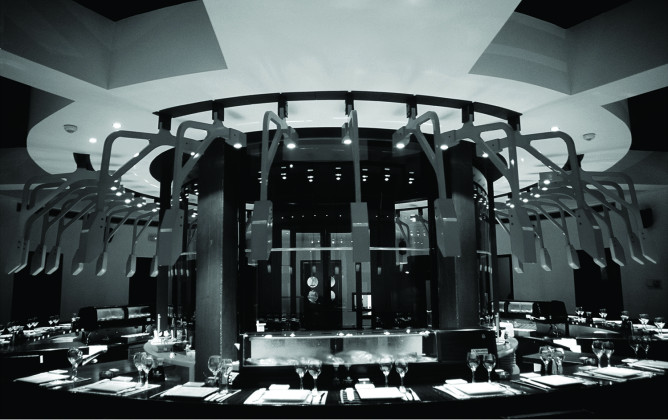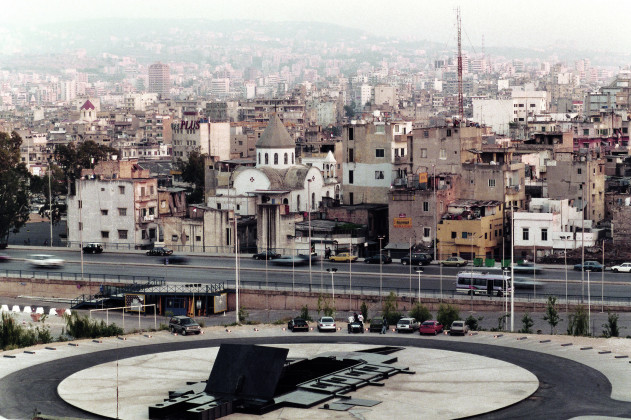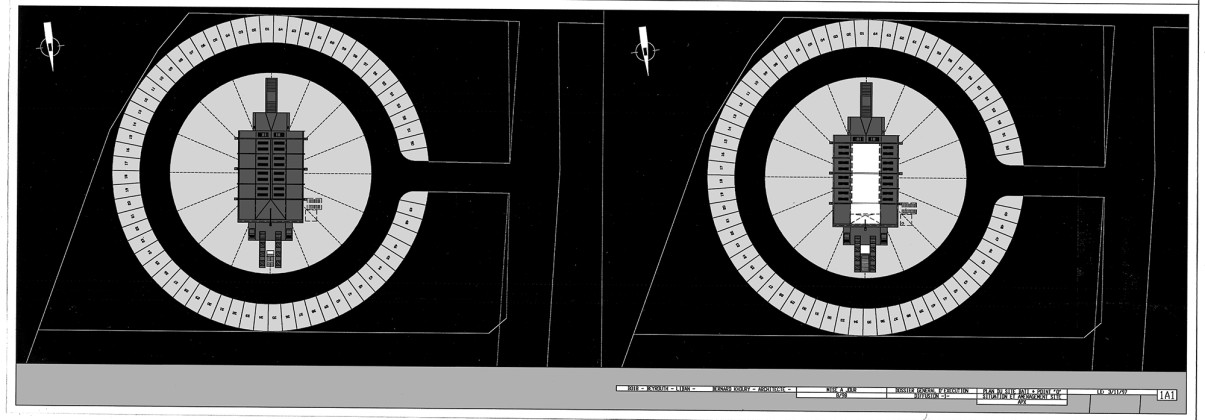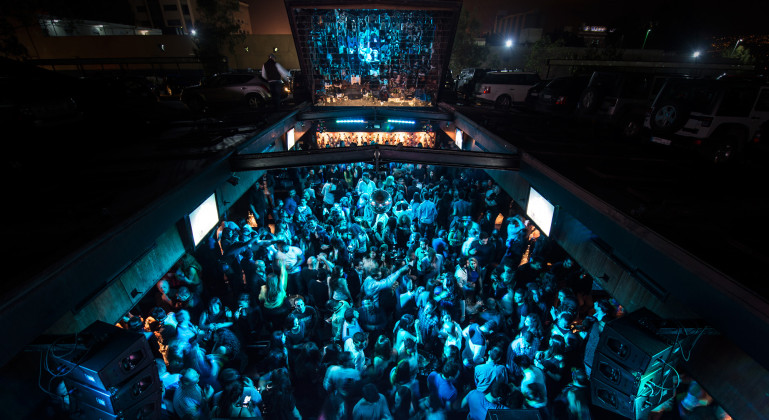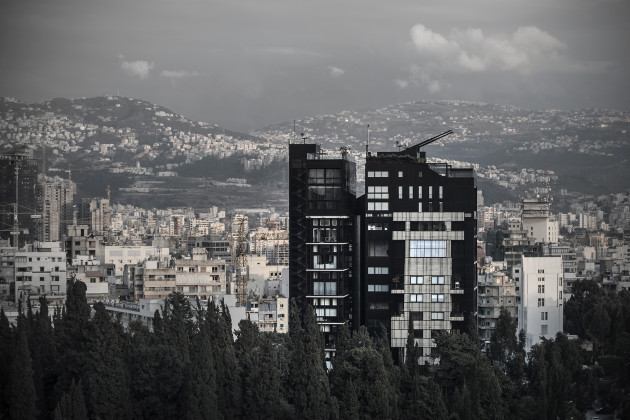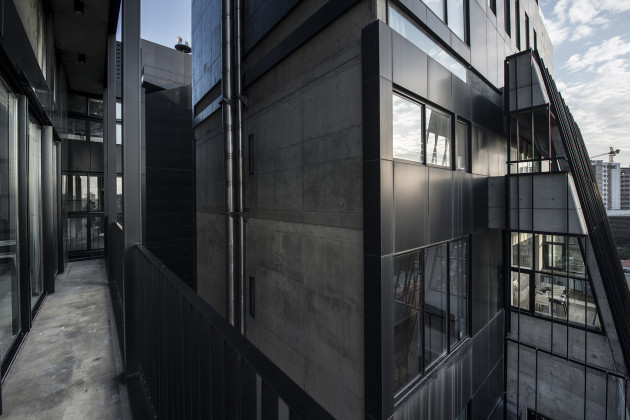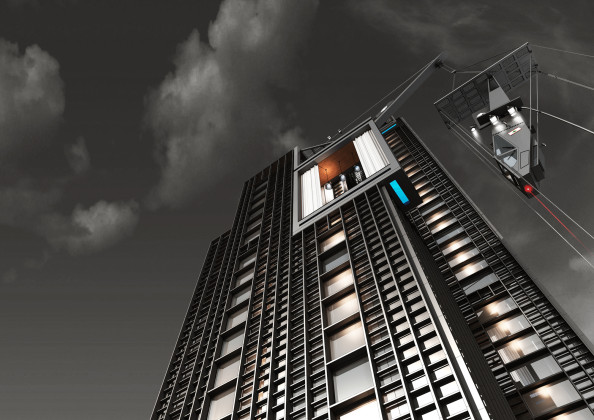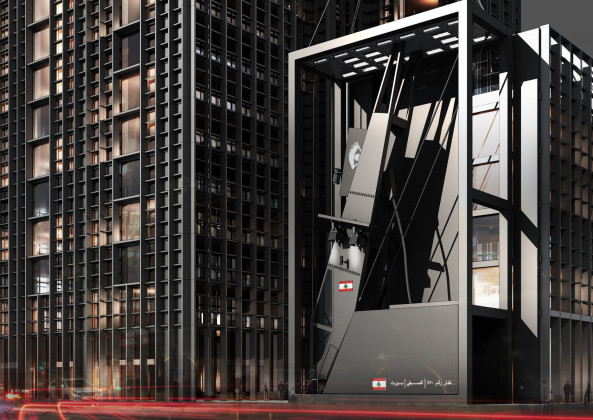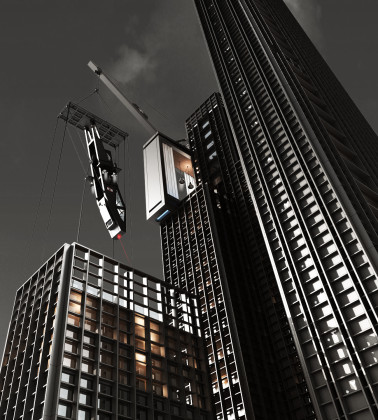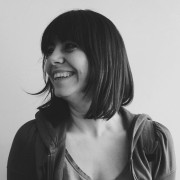Rethinking the Context of Architecture
We talk to Bernard Khoury about Beirut, his works and his critical approach towards the changing paradigms
Back in July, Bernard Khoury directed a workshop organized by the M.Arch. program at Istanbul Bilgi University. We talk to the architect about Beirut, his works and his critical approach towards the changing paradigms.
Hülya Ertaş: In architectural discussions, context is defined mostly in relation to urban texture, climate, site’s topography, etc. But in your presentation at Bilgi University I realized that for you, the context is a broader concept. It involves the stakeholders of the projects; like bankers, clients and so on. I always think that there is more secrecy in an architect’s business than what is known. Do you think this approach may bring some honesty into the profession?
Bernard Khoury: I don’t know if it is a question of honesty. Mostly, it is a question of giving curiosity in the wrong or right direction. In the first part of my presentation, I talked about the accountability that architects feel relative to contexts and history in general, particularly, in very stable environments that produce very consensual definitions of a territory, at least on the very basic issues. For example in France, you cannot build for the state if you do not recognize the very basic values of the republic that commissions you these public projects. There is none of that where I come from. In Beirut, you’re subject to very diverse situations that come from an environment that is radically different, completely unregulated. Not that the western world or more stable environments are super regulated; we see the private sector has taken charge of the cities pretty much everywhere. But it has reached caricature proportions in where I came from. The state is completely absent, absolutely absent; no longer a player in the making of the fabric. So you are bound to hit realities that are very contradictory, sometimes. And you have to accept that you can produce definitions that are very contradictory—one to the other—sometimes, in response to very similar programs and in very close geographical proximities, and sometimes from one street corner to the other.
I very proudly contradicted myself without ever being cynical because of this curiosity; that is built for the very specific and the non-generic. And we come out with the things that are not general certainties. They are very specific responses to very specific obsessions; to the situation itself. The situation is very, very often driven by those who made these projects possible. They sometimes have contradicting interests and agendas, and I think it's far more an interesting approach to the context; one that, at the outset, is not worried about this sort of orthodox accountability; one that allows you to really go very deep into the very specific situation itself, in the very specific moment in time on a very specific geographical location.
HE: When the state is absent, then who defends the rights of the public? How is the public space generated?
BK: There is no public space in the conventional definition of the term in Beirut. In fact, there are no public buildings visible in the city. You find your way in Beirut by [going] around gas stations, shopping malls—not by museums and opera houses or public parks.
HE: How do architects operate in this system?
BK: We tried to develop a certain form of immunity. I showed many examples in my talk that very clearly outline the dangers of the unpredictable happenings. These can be literally at the edge of your site because no place is subject to any regulating mechanism or a master plan. It is subject to extremely complex generic laws that are also very archaic.
We have some kind of regulations like the maximum height and so on, but there is no thorough serious master planning that addresses the development of specific blocks, or neighborhoods; like it happens in every city. There is no serious study on the evaluation of the urban fabric. They raise exploitation factors without serious studies on the impact on the environment, on the city itself, on the fabric. And we have seen the catastrophic fabric developing from those conditions. So architects have to develop the mechanism of defense for every single site. Every single project requires a very specific strategy that becomes context to a certain extent.
HE: What about foreign architects doing projects in Beirut?
BK: They messed up. Lots of them failed to deliver a meaningful project in the so-called key sites, primarily in the Solidere project which is about the reconstruction of the city center. There was a list of international architects, at some point twenty of them. And we have seen them paraded one after the other on the main key sites but they messed up; because they produced generic certainties of their very basic and superficial understanding of the context, and of the history. Some of them who supposedly had this curiosity of the environment even tiptoed and produced very sterile and meaningless projects. Sometimes these were like secondary or third grade rehashing of existing recipes that produces something else. All those came in with some global certainties that they had perpetrated in China, Hong Kong, Dubai or Houston and perpetrated dots in Beirut. From the supposedly curious to the very confident, they both generated meaningless projects that have no relevant connection to the space [and] the time in which they were produced.
HE: But, business-wise? Did they succeed in this manner?
BK: No, I don’t think so. I think they flunked on all levels. From Steven Holl’s West Marina project to Norman Foster’s recently completed residential tower to Herzog & de Meuron’s Beirut Terraces. This last one looks like a quite interesting mass in its environment, but turns out to be catastrophic. Plans generate very deep slabs in complete contradiction to what it expresses on the outside. In fact, you start to understand there is a very superficial reading of interaction with the outside. The relationship between the inside and the outside becomes expressed in the façade that is very iconic; but then the result, in fact, in the plan, is a very deep slab. A building that is very international, completely disconnected from the space and time in which it is produced.
HE: Here in Istanbul, some very controversial huge projects are underway—like the third airport and Galataport. And most of these are designed by foreign architectural offices because of the risk of the local ones leaking information on these projects.
BK: Yes, that is [what’s] complex of the third world. I am a deep believer in the locals. Because the locals know and own the streets they walk on. They know the bad boys, they know the ins and outs, and they know the tricks. The locals know their stuff. They know the things that are lying within the invisible layers of the city that I think the curious foreigner cannot know. It cannot be achieved by accumulating data in a thick book and turning them into cute graphics. It is not about 500 pages of generic information that you end up on [in] understanding your context. This produces very, very consensual definitions of a territory, it produces dangerous simplifications of history, and this comes from [what’s] complex. The complex of the architectural field is its accountability to context, the context [which] the architect does not know. I do not have that problem. I do not try to be contextual. Simply because I have given up on trying to define what that context is in general terms. I am very proud to reinvent every street corner and construct it around the very specific situation that I am bound to. No matter how sour and how difficult the situation is.
HE:I think developing a criticism by practice is one of the biggest challenges. What are your tools, tactics or strategies to achieve this?
BK: I like to think the most relevant criticism comes out of the most difficult situations. Where it’s impossible is where it becomes interesting; where it is easy and obvious, it is not interesting. I have given up on building museums, opera houses, and those very consensual forms of power that are always the products that have very consensual history, one that everybody agrees democratically. I am not interested in that. I am interested in forging an intelligent and relevant relationship with those who made the projects possible. And for every time, it’s a very complex story. There is no recipe or miracle strategy that you repeat. You have to invent it according to every situation and every individual you work with.
The clients are not stupid. They have a certain form of intelligence you have to understand. They have agendas. They are pragmatic but it does not mean that building a sushi restaurant on a site that is shoulder to shoulder with a miserable building that is squatted by the refugees cannot produce meaning. We have not given in to absurd values that the beasty big bad capital machine has imposed on us. It is not true. I think our projects remain very critical; but criticism does not necessarily come only while sitting on your cloud up above in a theoretical posture, saying this is good or bad. I think working out of the mud, out of completely sour environments, sometimes can produce much more interesting meaning. Not sugar coated, not sweet, not naively optimistic, but there is a certain form of reality that I am very interested in.
HE: Have you ever felt that you are just going to be drawn into that mud while trying to work out of it?
BK: I am a very anxious person. I try to generate and also live [the] pleasure out of every single experience because [that] is very important. If today, I no longer have pleasure out of these experiences, then I quit. They are very dangerous; but there is some pleasure that’s driven out of danger. I do not want to be imprisoned in a monastery, preaching good values. No, I like the streets. I like the dangerous seas and [the] pirates.
HE: There might be a point [where] you cannot just convince your client and what comes out of this process cannot be good.
BK: You know, it is not a binary situation. I do not come with certainties to a project. It is not interesting if you know the right from the wrong before you start [the project]. I think you build very specific parameters around each specific project. So when I come in, I may be thinking something; but going through that experience, through that very tough and sometimes very conflicting process, that [thought] might change. Because we do live [though] very conflicting situations in the outline of those happenings. It is not a love at first sight. It is not a romantic, stable relationship that happens from beginning to the end. There is a lot of pressure. There is a lot of conflict. There is a lot of pushing and pulling back and forth. There is a lot of flirting with the limits of the possible. Always. But there is also a lot of seduction at work and you always have to keep your client secure, you have to take care of her/him. You push in a direction and suddenly you realize that the force that is against you sometimes may lead you somewhere—so you go with it. You might break a few teeth on the way and get a few scratches, it does not matter. I have a lot of scars on my body, but it does not matter because it is a part of practicing. And I may die twenty years before my time. But it is okay.
HE: Since the modern times, there has been a belief that architecture has some kind of a power. What do you think is the ability of the architect now?
BK: Not much, as you can see when you look around. I do not want to pull you back too far away in history; but as French theorist Paul Virilio of the 1980s used to say: “It is all related to speed.’’ Virilio talked about moving at animal speed until mechanical revolution of the age of the machine, so let’s say, the 19th century. Up until that point, we evolved at animal speed, at the speed of walking, running, on the back of donkeys or camels or horses, or with the force of wind, at the speed of the sea, through sails or rowing or so on... But then, at some point there was a very sudden break; an acceleration at the speed [with which] we moved. That brought with it major demographic revolutions, revolutions on every field from medical to scientific. And this brought two world wars with it. Architectural thoughts could take parts of that revolution. While the architect was at the right hand side of the ruler up until the mechanical speed, after that, he started losing ground during the mechanical age. We thought at the beginning of modern times, that we could catch on, we could take part on that revolution and produce meaning and take part in the making of a culture. It turns out it did not really happen that way. We started questioning that by the 50s and 60s. There are already some severe criticisms to what modernism -not modernity- had produced, at least in our field.
But after that a much more dramatic acceleration came, which is the transition from the mechanical speed to the electronic speed. That is the revolution our generation is witnessing. And I think it is a major break in how we perceive space and time; where our bodies don’t even move in order to go from one space to another, or experience one space or another. Meaning is produced through other means nowadays. They are much more dynamic, much more fluctuating. And they produce phenomenon that come and go at much faster pace. I wonder how our practice will survive that. Some said that we are the last pocket of resistance to speed. But I do not want to be in denial of this phenomenon. We have to recognize it and not sit comfortably in the Stone Age. We have to fight. If we are resisting that, we have to be aware of this and generate the tools to develop a constructive, intelligent form of resistance. One that could take part in the making of a culture; and no longer remain in that state which I feel today. Architecture has become much more a means of representing cultural phenomenon rather than producing cultural phenomenon. And I think that is a very sorry state. Architecture now in general, means formal justifications by twisting buildings, coordinating shifts or taking some very basic figurative ways and representing itself through very primitive means, while [the] phenomena that are happening are much more dynamic, with more complex mechanisms.
HE: I find the contemporary architecture more conservative than any other areas. It seems to perform a resistance to the changes going on in society, technology, and so on.
BK: Yeah. Architecture is in a very superficial engagement with culture; with very superficial representations of political, social, technological, scientific, philosophical factors. And a very complex syntax makes architecture’s productions seem like complex—but it is not, in fact. When you scratch beyond the surface of these very complex façades, and very complex drawings, you will see that the narrative or the posture behind [them] is in fact a very simplistic one, a dangerously simplistic one.
HE: I think, one of the chances you had was that you started your business in the entertainment sector, where experience is more important than anything. And I think the experience of space is not considered that important for the architecture of today.
BK: You are right [in] that entertainment allows you to try something new, also because they are ephemeral projects. They are not bound to the accountability of permanence. By definition their program is not really taken seriously. Traditionally entertainment architecture is always dedicated to the basements of buildings. You do not dedicate buildings to them because they are not noble programs, they are vulgar programs. So, I think, in that territory, you can do much more because you are not accountable. You are not limited to conventions. I mean, I would not have been able to be so radical in the beginning with residential. If I had not gone through entertainment, I would not have gotten a certain level of credibility. And through that I was also banned from the residential sector; because people think that there are certain ways that people can live and cannot live. They can accept that you can go in and out of a club for two-three hours, have a few drinks in an absurd situation. But they think that there is a reasonable way of living. While you are raising your kids and living behind closed walls, that building has to respond to certain logic. There are in fact very stiff morals that produce bad societies, bad fabric, bad spaces. I think that is a fight we’re leading lately in the last few years, where we were able to basically take these issues of impermanence. When I started working for residential projects, there were some typologies like “core & shell” buildings where they ask the architect to design the core and the shell of the residential blocks and leave all the other stuff to people who buy the apartments. These typologies were imposed by the developers. We had a very coherent, consistent fight against the typologies they were prevailing. We fought very hard until we completely demolished them. But there was also a political fight [with it]. A much more complicated and difficult one than the ones I experienced while I worked for the entertainment industry.
HE: The terrorist attacks, refugees, and the rapid flow of users in the city are not new [things] for Beirut. It has been like this for thirty years, maybe. But now many cities around the world are becoming like that. Even a small town in Germany is not somewhere that can be counted as stable. What do you think that other cities can learn from Beirut in this sense?
BK: Well, I think today, with this fear of the security which no city is immune to, we are going to have to deal with other tools that architecture never really addressed. And from the bar wire to the concrete blocks, to the garrets of the soldiers to military and security apparatuses, we will have to reconsider some elements which architects have never given any architectural expressions. For this, in my project Plot #450, I pulled the control room out of the ground and transformed it into the most visible instrument that gives itself as a spectacle to the city. I think we are going to have to deal with these elements that do not necessarily fit this sometimes very positivist notion of the city and space. We liked describing cities as free flowing territories over the last decades, and earlier in the history of architecture. But today there are realities that we have to live with critically, but we have to recognize them first. So, maybe the tools of present are no longer the conventional tools of urbanists and architects. We have to deal with check points, electronic intelligence, mechanical apparatuses, defined boundaries, bar wired concrete blocks; and really manipulate those in a critical way. I am not saying we have to abide by the rules of the fear of security, but I think there are limits we are going to have to start to flirt with, and other tools we are going to start manipulating. And I think architects are bound to understand those, instead of negating them. I think denial of those could put them out of the game.
I was looking at the marvelous project that a friend of mine designed for the university in Beirut, not long ago. He basically designed a marvelous play of the pedestrian traffic into the campus through his building by a circulation scheme that basically wraps [up] his building. He had drawn a beautiful and naive circuit envisioning his building as a sponge that basically favored the circulation of pedestrians and the city favored it into the building. And suddenly, right after the building was completed; the university started erecting walls in his free-flowing plan. And it looks completely ridiculous today. It is the catastrophe of the naivety of the architect. You cannot keep up projecting an idealistic world where the rules of the game have changed. You do not have to [live] by [them] but you have to recognize them. And from then on, you can start drawing a critical posture; since, denial, on its own is not critical.
Related Content:
-
Seeds of Awareness
In the guidance of Michael Leung, this interview looks into a collective movement that flourishes at a street stall in Hong Kong as a reaction to the current development plans
-
Practice of Practices
How can we generate solutions in real life to our most prominent urban issues like sustainability, mobility, equality, etc.?
-
Handmade Inspirations
The world agenda full of crises makes it necessary for architectural practice to take a new look at the built and natural environment, and to develop new perspectives
-
Educational Possibilities in Urban Refurbishment
Critical Concrete, concentrating on the refurbishment of socially relevant spaces of Porto suburbs, shows us how to be super cool by being super normal
-
Reframing the Social
Hülya Ertaş talked to Florian Koehl on the social agenda of architects today and the alternative ways of realizing projects within the existing social and economical framework
-
Unlocking Architecture’s Potential to Invest in Future
Engin Ayaz and Christian Benimana of MASS discuss how architecture should function, as well as looking into the facts of social design in Africa
-
Inhabiting the Earth in Symbiosis with the Environment
Aixopluc takes on the challenge to find new modes of inhabitation in symbiosis with planet earth
-
Architecture as a Tool of Negotiation between Past and Future
Centrala adopts a design approach that considers the past as a source of overlooked yet valuable expressions
 20.10.2016
20.10.2016



